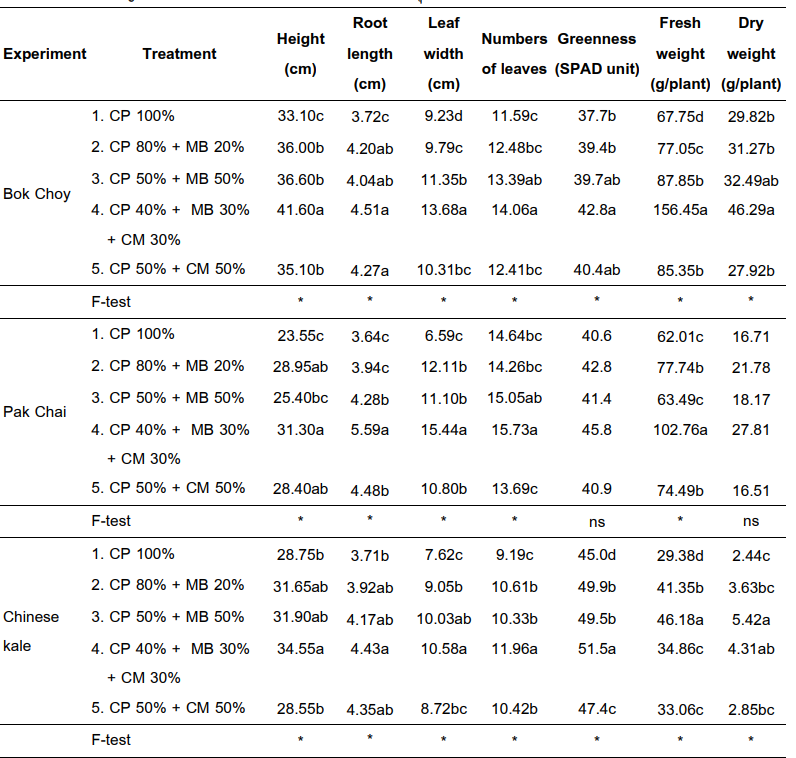EFFECT OF BIOCHAR AS AMENDMENT OF POTTING SOIL ON GROWTH AND YIELD OF THREE LEAF VEGETABLES GROWN IN RAISED GARDEN BEDS
Main Article Content
Abstract
Biochar, a material derived from pyrolysis process under limited- oxygen condition, is light weight and can be a source of plant nutrition which mostly made from agricultural waste. The objectives of this study were to characterize biochars that made form tree branches, bamboo, durian shell and biochar mixed (MB) from these biochars at rates of 50, 30 and 20% by weight, respectively. Furthermore, to study effect of biochar combined with commercial potting soil (CP) and cow manure (CM) at different rates on growth and yield of three green vegetables such as Bok Choy, Pak Chai and Chinese kale planted in raised beds. Each of experimental design was randomized complete block (RCB) with 5 treatments and 48 plants or replications such as 1) 100%CP, 2) 80%CP + 20%MB, 3) 50%CP + 50%MB, 4) 40%CP + 30%MB + 30%CM and 5) 50%CP + 50%CM. Growth and yield of vegetables were collected 45 days after transplant as well as potting soil properties were analyzed after harvest. Results showed that all biochars were alkaline have pH at range of 8.06 – 9.87. Cation exchange capacity (CEC)of biochars varied with pH. Durian biochar contains highest concentrations of available P and exchangeable K which were 2,374 and 32,627 mg kg-1, respectively. Results of potting soil mixed from MB, CP, and CM showed that MB and CM promote growth vegetables compared to 100%CP, especially potting soil mixed from 40%CP + 30%MB + 30%CM significantly enhanced growth and yield all vegetables. For example, Bok Choy, Pak Chai gained approximately twice of fresh weight and promoted photosynthesis of Chinese kale noticeable from leaf greenness. Adding of MB lead pH and CEC of potting soil mix after harvest but has not effect on EC values also increase nitrogen use efficiency. In conclusion, this study supports the feasibility of adding mixed biochar up to a maximum of 50% in the potting soil that has no effect on growth and yield of the green vegetables.
Article Details

This work is licensed under a Creative Commons Attribution-NonCommercial-NoDerivatives 4.0 International License.
เนื้อหาและข่อมูลในบทความที่ลงตีพิมพ์ในวารสารวิชาการ เทคโนโลยี พลังงาน และสิ่งแวดล้อม บัณฑิตวิทยาลัย วิทยาลัยเทคโนโลยีสยาม ถือเป็นข้อคิดเห็นและความรับผิดชอบของผู้เขียนบทความโดยตรง ซึ่งกองบรรณาธิการวารสารไม่จำเป็นต้องเห็นด้วย หรือว่าร่วมรับผิดชอบใด ๆ
บทความ ข้อมูล เนื้อหา รูปภาพ ฯลฯ ที่ได้รับการตีพิมพ์ในวารสารวิชาการ เทคโนโลยี พลังงาน และสิ่งแวดล้อม บัณฑิตวิทยาลัย วิทยาลัยเทคโนโลยีสยาม ถือเป็นลิขสิทธิ์ของวารสารวิชาการ เทคโนโลยี พลังงาน และสิ่งแวดล้อม บัณฑิตวิทยาลัย วิทยาลัยเทคโนโลยีสยาม หากบุคคล หรือหน่วยงานใดต้องการนำทั้งหมด หรือส่วนหนึ่งส่วนใดไปเผยแพร่ต่อ หรือเพื่อกระทำการใด ๆ จะต้องได้รับอนุญาต เป็นลายลักษณ์อักษรจากวารสารวิชาการ เทคโนโลยี พลังงาน และสิ่งแวดล้อม บัณฑิตวิทยาลัย วิทยาลัยเทคโนโลยีสยาม เท่านั้น
References
พินิจภณ ปิตุยะ, ไววุฒิ ภู่ทอง สายฝน สินสมุทรไทย นัยนา พรมอุดม ปัญญารัตน์ สิงห์พยัคฆ์ ภัทรมาศ มากมูล กิติพัทธิ์ โพธิ์ศรี ศุภกร คำงาม และจริงใจ เพชรแก้ว. เอกสารองค์ความรู้ เรื่อง ถ่านชีวภาพ. ศูนย์ศึกษาการพัฒนาห้วยทรายอันเนื่องมาจากพระราชดำริ, จังหวัดเพชรบุรี, หน้า 28.
สายชล สุขญาณกิจ และสิริวรรณ สมิทธิอาภรณ์. ผลของถ่านชีวภาพร่วมกับการจัดการปุ๋ยต่อผลผลิตและความเข้มข้นธาตุอาหารในถั่วฝักยาวไร้ค้าง, วารสารวิทยาศาสตร์และเทคโนโลยี, 28(3), 2561, หน้า 443-454.
พชรพล เปียรักษา และสุขุมาภรณ์ แสงงาม. ผลของการประยุกต์ใช้ถ่านชีวภาพต่อการเติบโตและประสิทธิภาพของการสังเคราะห์ด้วยแสงของพริกขี้หนูซูเปอร์ฮอทภายใต้สภาวะดินเปรี้ยว, แก่นเกษตร, 46(1), 2561, หน้า 338-343.
เกศศิรินทร์ แสงมณี ธีระรัตน์ ชิณแสน และณัฐพงษ์ พันธภา. การศึกษาอัตราส่วนของถ่านชีวภาพต่อคุณสมบัติทางเคมีของดินปลูก การเจริญเติบโต และผลผลิตของผักสลัดกรีนคอส. เรื่องเต็มการประชุมวิชาการของมหาวิทยาลัยเกษตรศาสตร์ ครั้งที่ 53: สาขาพืช. มหาวิทยาลัยเกษตรศาสตร์. กรุงเทพมหานคร: 746-752. 2558.
จาวภา มะนาวนอก สันติไมตรี ก้อนคำดี เกษสุดา เดชภิมล วรรณวิภา แก้วประดิษฐ์ พลพินิจ และดรุณี โชติษฐยางกูร. ถ่านชีวภาพ: ผลต่อคุณสมบัติของดินและการเจริญเติบโตของข้าวนาหว่านน้ำตม (การทดสอบในสภาพกระถาง), แก่นเกษตร, 45(2), 2560, หน้า 209-220.
Butnan, S., J.L. Deenik, B. Toomsan, M. J. Antal and P. Vityakon. Biochar characteristics and application rates affecting corn growth and properties of soils contrasting in texture and mineralogy, Geoderma, 237(1), 2015, pp. 105-116.
รุ่งเพชร เกิดประกอบ และนัฐพร นันท์แก้ว. ผลของสารอัลลีโลพาธีจากถ่านเปลือกเมล็ดมะม่วงหิมพานต์ที่มีผลต่อการงอกและการเจริญเติบโตของผักและวัชพืช. วิทยาศาสตรบัณฑิต ปัญหาพิเศษ, มหาวิทยาลัยราชภัฎอุตรดิตถ์, 2561.
Cottenie, A. Soil and Plant Testing as a Basis of Fertilizer Recommendations. FAO Soils Bulletin No. 38/2. Food and Agriculture Organization of the United Nations, Rome, p. 118, 1980.
Black, C.A. Methods of Soil Analysis. Part II: Chemical and Microbiological Properties. American Society of Agronomy, Madison, Wisconsin. p. 1572, 1965.
สายจิต ดาวสุโข อรุณ คงแก้ว และอุราวรรณ อุ่นแก้ว. การพัฒนาถ่านชีวภาพจากเปลือกทุเรียนเพื่อใช้เป็นวัสดุปรับปรุงดิน และเพิ่มธาตุอาหารสำหรับเกษตรกรรม, วารสารผลงานวิชาการกรมวิทยาศาสตร์บริการ, 1(1), 2555, หน้า 133-141.
Sendi, H., M.T.M. Mohamed, M.P. Anwar and H.M. Saud. Spent mushroom waste as a media replacement for peat moss in Kai-Lan (Brassica oleracea var. Alboglabra) production. The Scientific World Journal. 2013, Artick ID 258562, doi : 10.1155/2013/258562.
Prakongkep, N., R.J. Gilkes and W. Wiriyakitnateekul. Agronomic benefits of durian shell biochar. Journal of Metals, Materials and Minerals, 24(1), 2014, pp. 7-11.
Lehmann, J., J. P. da Silva Jr., C. Steiner, T. Nehls, W. Zech and B. Glaser. Nutrient availability and leaching in an archaeological Anthrosol and a Ferralsol of the Central Amazon basin: fertilizer, manure and charcoal amendments, Plant and Soil, 249(1), 2003, pp. 343-357.
Van Zwieten, L., S. Kimber, A. Downie, S. Morris, S. Petty, J. Rust and K.Y. Chan. A glasshouse study on the interaction of low mineral ash biochar with nitrogen in a sandy soil, Australian Journal of Soil Research, 48(7), 2010, pp. 569-576.
เสาวคนธ์ เหมวงษ์. ผลของถ่านชีวภาพจากไม้ไผ่ และแกลบต่อผลผลิต และประสิทธิภาพการดูดใช้ไนโตรเจนของข้าวพันธุ์ชัยนาท 1, วารสารวิทยาศาสตร์และเทคโนโลยี มหาวิทยาลัยอุบลราชธานี, 16(1), 2557, หน้า 69-75.


